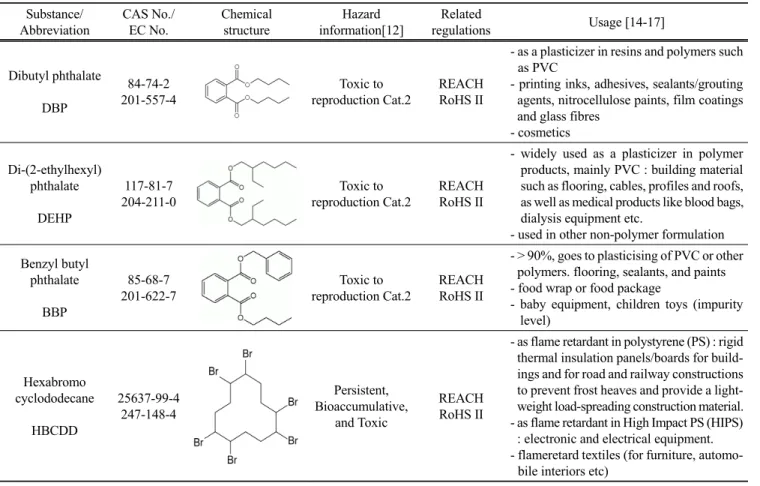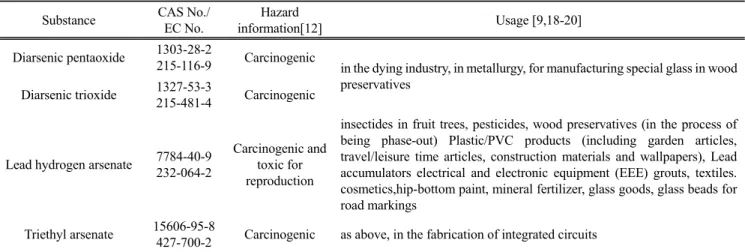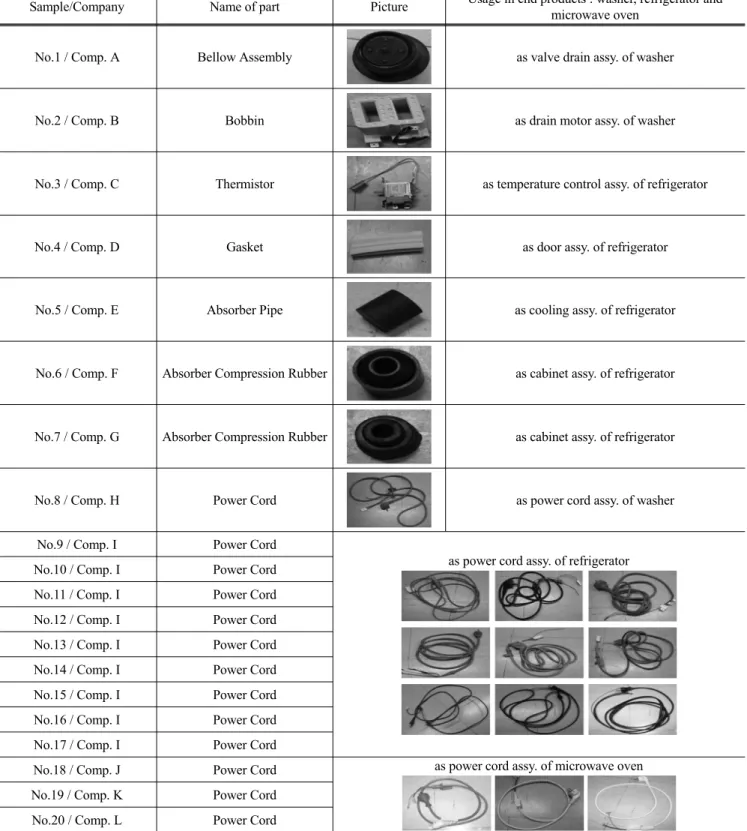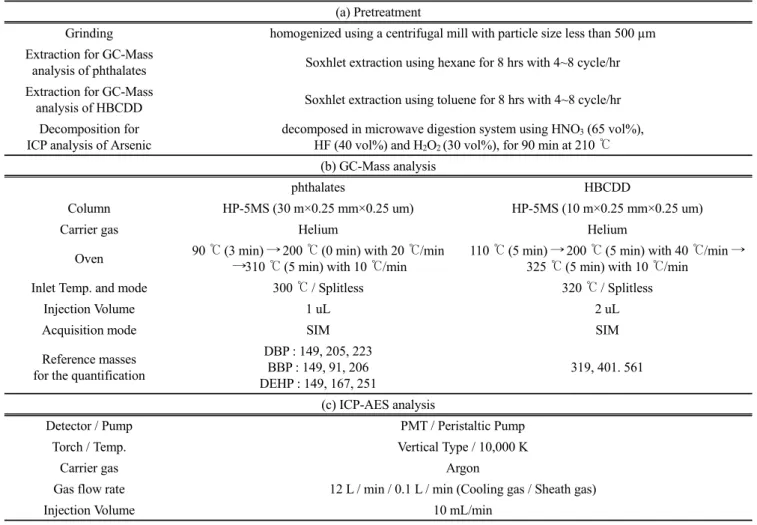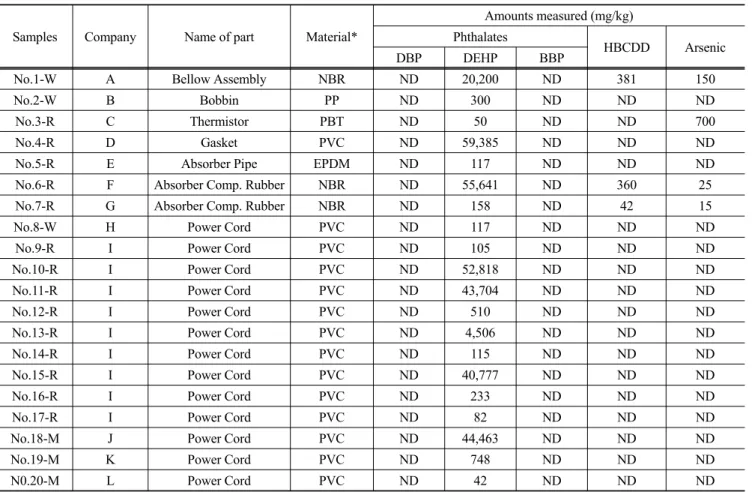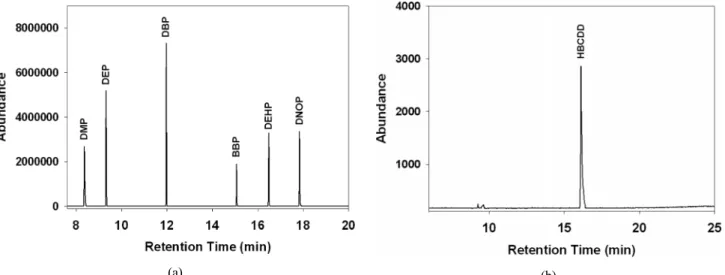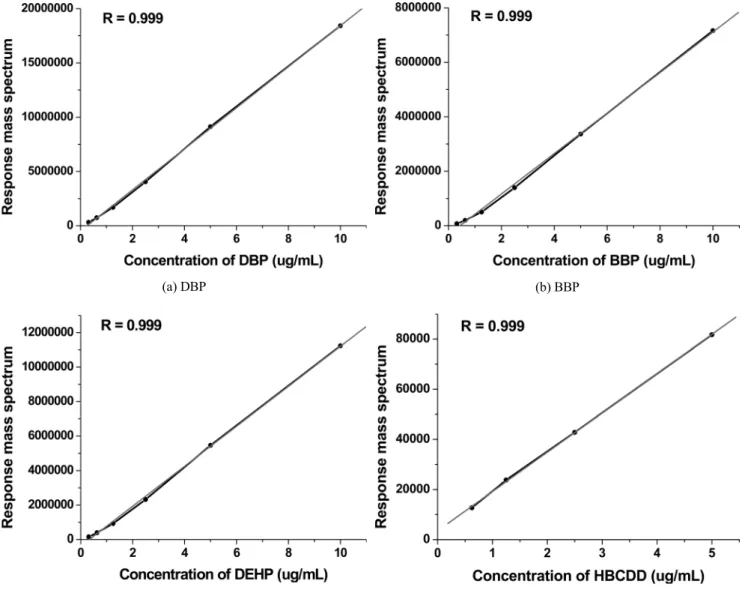* To whom correspondence should be addressed.
E-mail: ekchoe@kitech.re.kr 청정소재제품기술
국내 전기전자 제품에 함유된 신규 RoHS II 물질 검출 사례 연구
송문환
,
손승환,
조영달,
최은경*
한국생산기술연구원 국제환경규제대응기술지원단 유해물질분석실 426-910 경기도 안산시 상록구 사3동 1271-18
(2011 년 5 월 27 일 접수 ; 2011 년 6 월 20 일 수정본 접수 ; 2011 년 6 월 22 일 채택 )
Case Study on Determination of the Level of New RoHS II Substances in Domestic Electronic and Electrical Equipments
Moon Hwan Song, Seung-Hwan Son, Young Dal Cho, and Eun Kyung Choe*
Products Eco-testing Laboratory, Korea Institute of Industrial Technology, 1271-18 Sa3-dong, Sangrok-gu, Ansan 426-910, Korea (Received for review May 27, 2011; Revision received June 20, 2011; Accepted June 22, 2011)
요 약
2006년 시행되어 온 RoHS 규제에 유해물질을 추가하여 더 강화된 RoHS II의 공표에 대비하여 본 연구에서는 RoHS II의 최 우선 규제 물질이면서 2010년 발표된 REACH SVHC 후보목록에도 포함된 물질인 Hexabromocyclododecane (HBCDD) 및 3 종 프탈레이트, Dibutyl phthalate (DBP), Butyl benzyl phthalate (BBP), Diethylhexyl phthalate (DEHP)의 국내 전기전자제품 내의 함유 여부를 사전 검토해보려는 목적으로 사례 연구를 진행하였다. 이에 고분자 소재로 구성된 세탁기, 냉장고, 혹은 전 자렌지의 부품 20개를 12개 전기전자 부품 생산회사로부터 수거하여 4종 규제 물질을 기체크로마토그래피 질량분석법으 로 분석하여 그 함유량을 측정한 결과 Nitrile Butadine Rubber (NBR), Polypropylene (PP), Polybutylene Terephthalate (PBT), Ethylene Propylene Rubber (EPDM), Polyvinyl Chloride (PVC) 등의 소재로 된 부품 중 HBCDD는 NBR 소재로 된 3종 부품에 서 42~381 mg/kg 범위로 검출되어 규제값 0.1 wt% (1,000 mg/kg)보다는 적지만 주의를 요한다. DBP 및 BBP는 20개 부품 모 두에서 검출되지 않고 있어 이 두 물질은 전지전자 제품용 플라스틱 소재에서 넓게 사용되지 않고 있을 가능성을 시사하고 있다. 그러나 DEHP는 40~59,400 mg/kg 범위로 NBR, PP, PBT, EPDM 및 PVC로 이루어진 부품에서 모두 검출되어 광범위 하게 사용되고 있음을 알 수 있었고 특히 NBR 및 PVC로 이루어진 8개 부품에서 예상 규제치인 0.1 wt% (1,000 mg/kg)을 훨 씬 능가한 0.45~5.94 w%로 검출되고 있어 이에 대한 대비가 필요함을 알 수 있었다. 추가로 REACH SVHC(고위험성 물질) 에 속하는 Diarsenic pentaoxide, Diarsenic trioxide, Lead hydrogen arsenate, Triethyl arsenate의 4종 물질의 함유 여부를 ICP에 의한 비소(Arsenic) 분석으로 스크리닝해 본 결과 NBR, PBT 소재의 4개 부품에서 15~700 mg/kg으로 검출되었고 이 중 PBT 소재의 부품인 Thermistor에서는 규제되는 비소화합물이 규제값(0.1 wt%, 1,000 mg/kg)을 초과할 가능성이 매우 높다.
주제어 : 전기전자 제품, 유해물질 검출, 난연제, 프탈레이트, 비소, 기체크로마토그래피 질량분석법
Abstract : In addition to six substances regulated in EU RoHS including lead, mercury, cadmium, hexavalent chromium, polybrominated biphenyls (PBB) and polybrominated diphenyl ethers (PBDE), priority substances are identified in new RoHS II as hexabromocyclododecane (HBCDD), dibutyl phthalate (DBP), butyl benzyl phthalate (BBP) and diethylhexyl phthalate (DEHP).
In this study, 20 plastic samples were collected from 12 domestic electrotechnical companies and levels of four restricted substances were determined by gas chromatography-mass spectrometry. Among 20 parts that compose washer, refrigerator or microwave oven, HBCDD was detected in three samples of NBR material with the amount of 42~381 mg/kg while DBP and BBP was not detected in any samples collected respectively, implying that these substance may not be used widely in plastic materials for EEE.
However, DEHP was detected in all samples of NBR, PP, PBT, EPDM and PVC materials with the amount of 42 up to 59,400 mg/kg that exceeds the limit value of 0.1 wt% (1,000 mg/kg). Presence of a restricted substance in polymer material makes a great negative influence on a number of final product. To cope with coming RoHS II as well as REACH, action not to use DEHP in plastic material or the relevant notification in case of REACH seems to be needed. Screening test of Arsenic compounds such as diarsenic pentaoxide, diarsenic trioxide, lead hydrogen arsenate, triethyl arsenate that are included in REACH SVHC was done by ICP measurement. Arsenium was detected in four samples made of NBR and PBT materials in the level of 15~700 mg/kg. By considering the screening method used in this study, the amount of arsenium compounds in the thermistor made of PBT material has a high chance of exceeding the regulated limit value.
Keywords : Electronic and electrical equipments, RoHS II, Phthalate, HBCDD, Arsenic compound, GC-Mass, ICP
124
Table 1. Summarized information of phthalates and HBCDD prohibited on use Substance/
Abbreviation
CAS No./
EC No.
Chemical structure
Hazard information[12]
Related
regulations Usage [14-17]
Dibutyl phthalate DBP
84-74-2 201-557-4
Toxic to reproduction Cat.2
REACH RoHS II
- as a plasticizer in resins and polymers such as PVC
- printing inks, adhesives, sealants/grouting agents, nitrocellulose paints, film coatings and glass fibres
- cosmetics Di-(2-ethylhexyl)
phthalate DEHP
117-81-7 204-211-0
Toxic to reproduction Cat.2
REACH RoHS II
- widely used as a plasticizer in polymer products, mainly PVC : building material such as flooring, cables, profiles and roofs, as well as medical products like blood bags, dialysis equipment etc.
- used in other non-polymer formulation Benzyl butyl
phthalate BBP
85-68-7 201-622-7
Toxic to reproduction Cat.2
REACH RoHS II
- > 90%, goes to plasticising of PVC or other polymers. flooring, sealants, and paints - food wrap or food package
- baby equipment, children toys (impurity level)
Hexabromo cyclododecane
HBCDD
25637-99-4 247-148-4
Persistent, Bioaccumulative,
and Toxic
REACH RoHS II
- as flame retardant in polystyrene (PS) : rigid thermal insulation panels/boards for build- ings and for road and railway constructions to prevent frost heaves and provide a light- weight load-spreading construction material.
- as flame retardant in High Impact PS (HIPS) : electronic and electrical equipment.
- flameretard textiles (for furniture, automo- bile interiors etc)
1.
서 론RoHS (Restriction of the use of certain Hazardous Substances in electrical and electronic equipment)는 전기 및 전자 장비 내 특정 유해물질의 사용에 대한 제한 지침으로 유럽의회 및 유럽연합심의회에서 제안하여 2006년 7월부터 시행되어 왔 다[1]. RoHS의 시행으로 납(Pb), 수은(Hg), 카드뮴(Cd), 6가 크 로뮴(Cr(Vl)) 및 두 가지 유형의 브로민계 난연제인 폴리브로 민화바이페닐(PBB)과 폴리브로민화다이페닐에테르류(PBDEs) 의 6종 물질(substance)이 허용 농도 0.01 wt%(카드뮴) 및 0.1 wt%(기타 물질)로 규제되어 왔고, 관련 회사들의 적극적인 품 질관리 대응으로 시행 초기와는 달리 더 이상 전기 및 전자제 품에서 검출되지 않고 안정화되어 있는 현황이며, 그 시험법도 국제표준인 IEC 62321 및 이의 KS 표준에 규정되어 있다[2,3].
그러나 RoHS 지침서(Directive) 제6조의 유해물질 추가 검 토에 대한 명시와 함께 할로겐 난연제 대체를 완료한 Acer, HP, Dell, Sony, Ericsson 등 일부 글로벌 기업들과 Chemsec (The International Chemical Secretariat)[4] 및 Greenpeace[5] 등 의 지속적인 추가 물질에 대한 사용제한 요구 등으로 규제 물 질의 확대 및 강화는 불가피하게 진행되어 왔다[6,7]. 2008년 Oeko-Institut에서 RoHS 지침서에서 규제되고 있지 않는 전기 전자제품 함유 유해물질에 관한 연구를 실시하였고 전기전자 제품의 생산자 및 공급자들이 제공한 자기 선언(Declaration) 과 XRF 분석 등의 정보에 기초하여 46종 후보물질 목록
(Inventory)이 작성되었다[8,9]. 2008년 EU집행위에서 규제대 상 물질을 추가하여 더 강화된 RoHS II 초안문(RoHS 개정안) 이 제안된 이래[10], 이에 대한 수정안이 2009년, 2010년 두 차 례 제안되고 검토되는 과정을 거치며 최종 발표 및 시행을 앞 두고 있다. RoHS 개정의 진행 과정에서 언급되고 있는 고려 대상물질(부속서 III)은 비소계 화합물, 베릴륨과 그 화합물, 삼산화 안티몬, Dinickeltrioxide, 비스페놀 A, 브롬계 난연제 를 제외한 유기 브롬(Organobromines), 염소계 난연제 또는 가소제를 제외한 유기 염소(Organochlorines)의 7종이며, 새로 운 제한물질(부속서 IV)은 브롬계 난연제(Brominated flame retardants), 염소계 난연제(Chlorinated flame retardants), PVC (Polyvinylchloride), 염소계 가소제Chlorinated plasticizers), DEHP, BBP, DBP이며 7종 새로운 제한물질의 규제값은 0.1 wt% 이 다[6,7].
EU에서 2007년 6월 시행된 EU 新화학물질관리규정인
REACH (Registration, Evaluation, Authorization, and Restric-
tion of CHemicals) 법령에서는 CMR (Carcinogenic, Mutagenic
or Toxic for Reproduction), PBT (Persistent, Bioaccumulative
and Toxic) 및 vPvB (very Persistent and very Bioaccumulative)
물질을 고위험성 물질(SVHC, Substances of Very High Con-
cerns)로 정의하고[11] 유럽화학물질청(ECHA, European Che-
micals Agency)에서 2008년 10월 및 2010년 1월 두 번에 걸쳐
REACH SVHC 허가 후보목록(총 30종)을 발표한 바 있다
Table 2. Application areas of arsenic compounds in candidate list of REACH SVHC Substance CAS No./
EC No.
Hazard
information[12] Usage [9,18-20]
Diarsenic pentaoxide 1303-28-2
215-116-9 Carcinogenic
in the dying industry, in metallurgy, for manufacturing special glass in wood preservatives
Diarsenic trioxide 1327-53-3
215-481-4 Carcinogenic
Lead hydrogen arsenate 7784-40-9 232-064-2
Carcinogenic and toxic for reproduction
insectides in fruit trees, pesticides, wood preservatives (in the process of being phase-out) Plastic/PVC products (including garden articles, travel/leisure time articles, construction materials and wallpapers), Lead accumulators electrical and electronic equipment (EEE) grouts, textiles.
cosmetics,hip-bottom paint, mineral fertilizer, glass goods, glass beads for road markings
Triethyl arsenate 15606-95-8
427-700-2 Carcinogenic as above, in the fabrication of integrated circuits
[12]. 이를 반영하여 2010년 EU의회의 환경위원회에서 RoHS II 고려대상물질 목록에 REACH SVHC 30종을 추가로 제안 하여, 현재 확대되어 있다[7]. RoHS 개정안을 보면 신규 규제 물질의 추가는 REACH에서 수립된 방법론을 이용하여 검토 하도록 되어 있어[7,10] 향후에도 REACH SVHC 후보물질과 밀접한 영향이 있을 전망이다.
RoHS II의 최우선 규제물질(priority substances)은 Hexabro- mocyclododecane (HBCDD) 및 Dibutyl phthalate (DBP), BBP (Butyl benzyl phthalate), DEHP (Diethylhexyl phthalate) 3종 프 탈레이트이며[13] 이 물질들은 유럽화학물질청(ECHA, Euro- pean Chemicals Agency)에서 2008년 발표한 15종 SVHC 후보 목록에도 포함된 물질이다[12]. HBCDD의 주요 용도는 폴리 스타이렌 고분자용 난연제이며, 3종 프탈레이트는 PVC 등의 고분자에 가소제로 사용되며 각 물질의 규제 사유가 되는 유 해성(Hazard) 및 용도는 Table 1과 같다[9,14-17,18-20].
RoHS II의 최종 입법까지는 아직 적지 않은 절차와 시간이 소요될 예정이지만 국내기업의 대비가 필요한 시점이다. 이 에 본 연구에서는 국내 전기전자제품 내에 RoHS II 규제 물 질인 HBCDD 및 3종 프탈레이트, DBP, BBP, DEHP의 함유 여부를 사전 검토해보려는 목적으로 국내 전기전자 부품 기 업의 생산품을 대상으로 사례 연구를 진행하였다. 추가로 비 소화합물(Arsenic Compounds, Table 2)의 함유 여부도 비소 (Arsenic) 측정에 의하여 스크리닝(Screeing) 해보았다.
2.
실 험2.1. 대상 부품 수집
세탁기, 냉장고 및 전자레인지 등의 대표적 가전제품을 구 성하는 부품 중에서 난연제 및 가소제를 함유할 가능성이 있 는 플라스틱 재질로 구성된 부품을 수집하도록 계획하였고 최종 완제품 생산기업의 도움을 받아 이들 부품을 생산하여 납품하는 협력업체를 통하여 수집하는 방식으로 진행하였다.
12개 회사의 20개 부품(7종)을 수집하면서 이들 부품의 용도 및 재질을 함께 조사하였다(Table 3).
2.2. 시약, 장비 및 기기 2.2.1. 시약
톨루엔과 헥산은 GC급을 사용하였고, 헬륨과 아르곤은 순 도 99.999 vol%, 99.9999 vol%을 사용하였다. HBCDD와 3종 프탈레이트는 각 Sigma-Aldrich사 및 Supelco사에서 시약급 (표준시약)으로 구입하여 정제없이 사용하였다. 비소(As) 표준 시약은 MERCK사에서 구입하여 사용하였고(농도 1,000 mg/L), 질산(nitric acid, HNO
3), 불산(hydrofluoric acid, HF) 및 과산 화수소(hydrogen peroxide, H
2O
2)는 각 65 vol%, 40 vol% 및 30 vol% 농도의 시약급이었다. 증류수는 RO (Reverse Osmosis) Filter로 처리 후 전기전도도 측정값이 18.2 Ω인 2차 증류수를 사용하였다.
2.2.2. 장비 및 사용기기
시료 분쇄에는 Centrifugal mill (Pulverisette 14, Germany), 그리고 프탈레이트 및 HBCDD 분석을 위한 시료 추출에는 250 mL 용량의 속스레 장치가 사용되었다. 비소(As) 분석을 위한 시료 용해에는 microwave digestion system (Milestone, Ethos Touch Control, Italy)이 사용되었다. HBCDD 및 프탈레 이트의 정량분석에는 GC-Mass (Gas Chromatography-Mass Spectometry) (Agilent, HP 6890, HBCDD 검출은 MS (5975i)/
프탈레이트 검출은 MS (5973N))을 사용하였고 비소(As)의 정량분석에는 ICP-AES (Inductively Coupled Plasma-Atomic Emission Spectrometer) (Jovin-Yvon, Ultima II, Horiba)를 사 용하였다. 국제 및 KS 표준분석법에서 권장하는데로[2,3] 반 복성(Repeatability)을 위하여 자동시료 채취장치(autosampler) 를 사용하였다(GC-Mass 7683 series injector, Agilent).
2.3. 시료 샘플링
수집된 세탁기, 냉장고 및 전자레인지의 구성 부품 20개(7
종)에서 플라스틱 재질로 된 부분을 물리적으로 분리하여
Centrifugal mill을 사용하여 추출 전에 균일하게 500 µm의 체
를 통과할 수 있도록 분쇄한다. 액체 질소로 냉각시키는 저온
분쇄가 권장된다[2,3].
Table 3. Information of electrical and electronic parts collected from 12 companies for the case study
Sample/Company Name of part Picture Usage in end products : washer, refrigerator and microwave oven
No.1 / Comp. A Bellow Assembly as valve drain assy. of washer
No.2 / Comp. B Bobbin as drain motor assy. of washer
No.3 / Comp. C Thermistor as temperature control assy. of refrigerator
No.4 / Comp. D Gasket as door assy. of refrigerator
No.5 / Comp. E Absorber Pipe as cooling assy. of refrigerator
No.6 / Comp. F Absorber Compression Rubber as cabinet assy. of refrigerator
No.7 / Comp. G Absorber Compression Rubber as cabinet assy. of refrigerator
No.8 / Comp. H Power Cord as power cord assy. of washer
No.9 / Comp. I Power Cord
as power cord assy. of refrigerator No.10 / Comp. I Power Cord
No.11 / Comp. I Power Cord No.12 / Comp. I Power Cord No.13 / Comp. I Power Cord No.14 / Comp. I Power Cord No.15 / Comp. I Power Cord No.16 / Comp. I Power Cord No.17 / Comp. I Power Cord
No.18 / Comp. J Power Cord as power cord assy. of microwave oven No.19 / Comp. K Power Cord
No.20 / Comp. L Power Cord
2.4. 대상 부품에서 프탈레이트 및 HBCDD 분석 2.4.1. 시료 추출
2.3에 따라 균질하게 분쇄된 시료는 전자저울을 이용하여 2 g을 측정한 후 셀룰로오스 재질인 원통형 추출 심블(thim- ble)에 담아, 프탈레이트 분석을 위해서는 헥산 약 90 mL,
HBCDD 분석의 경우 톨루엔 약 90 mL을 이용하여 1시간 당
용매 순환속도가 4~8회가 되도록 온도를 맞추고 8시간 이상
추출을 하였다. 속슬렛 장치로 추출된 용액은 0.45 µm 실린
지 필터로 여과한 후 100 mL 부피 플라스크에 담아 추출 시
사용했던 동일 용매로 표시부분까지 부피를 맞춘 후 GC 자동
시료 채취장치용 2 mL vial에 옮겨졌다.
Table 4. Details on (a) pretreatment, (b) GC-Mass analysis, and (c) ICP analysis (a) Pretreatment
Grinding homogenized using a centrifugal mill with particle size less than 500 µm Extraction for GC-Mass
analysis of phthalates Soxhlet extraction using hexane for 8 hrs with 4~8 cycle/hr Extraction for GC-Mass
analysis of HBCDD Soxhlet extraction using toluene for 8 hrs with 4~8 cycle/hr Decomposition for
ICP analysis of Arsenic
decomposed in microwave digestion system using HNO
3(65 vol%), HF (40 vol%) and H
2O
2(30 vol%), for 90 min at 210 ℃
(b) GC-Mass analysis
phthalates HBCDD
Column HP-5MS (30 m×0.25 mm×0.25 um) HP-5MS (10 m×0.25 mm×0.25 um)
Carrier gas Helium Helium
Oven 90 ℃ (3 min) → 200 ℃ (0 min) with 20 ℃/min →310 ℃ (5 min) with 10 ℃/min
110 ℃ (5 min) → 200 ℃ (5 min) with 40 ℃/min → 325 ℃ (5 min) with 10 ℃/min
Inlet Temp. and mode 300 ℃ / Splitless 320 ℃ / Splitless
Injection Volume 1 uL 2 uL
Acquisition mode SIM SIM
Reference masses for the quantification
DBP : 149, 205, 223 BBP : 149, 91, 206 DEHP : 149, 167, 251
319, 401. 561 (c) ICP-AES analysis
Detector / Pump PMT / Peristaltic Pump
Torch / Temp. Vertical Type / 10,000 K
Carrier gas Argon
Gas flow rate 12 L / min / 0.1 L / min (Cooling gas / Sheath gas)
Injection Volume 10 mL/min
2.4.2. 표준용액의 제조
GC-Mass 검량곡선 작성을 위하여 3종 프탈레이트와 HBCDD 에 대한 표준용액을 제조하였다. EPA phthalate esters 혼합용 액(각 2,000 ug/mL, hexane)을 이용하여 0.3125, 0.625, 1.25, 2.50, 5.00, 10.00 ug/mL 농도의 프탈레이트 3종(DBP, BBP, DEHP) 표준용액을 제조하였고, 톨루엔으로 1,000 ug/mL 농 도의 HBCDD 용액을 제조한 후, 0.625, 1.25, 2.50, 5.00 ug/mL 농도의 HBCDD 표준 용액을 제조하였다.
2.4.3. GC-Mass 분석
속슬렛 추출에 의해 분석 대상물질을 추출한 후 기체크로 마토그래피와 질량분석법으로 프탈레이트와 HBCDD를 1개 의 시료에 대하여 2회 반복(전처리부터 2회) 분석하였으며, 총이온전류 질량분석방법(전 주사법)으로 물질을 확인한 후, 선택이온 모니터링(SIM)을 이용해 정량되었고 이에 사용된 컬럼 및 기기분석 조건 등은 Table 4에 정리하였다. 3종의 Phthalates의 경우 0.3125~10 ug/mL 범위에서 제조된 6개 표 준용액을 3회 반복측정하여 검량곡선을 작성하였고, HBCDD 또한 0.625~5 ug/mL 범위에서 제조된 4개 표준용액을 이용하 여 3회 반복 측정하여 검량곡선을 작성하였다. 시료에 함유 된 프탈레이트 및 HBCDD의 농도는 외부 표준물(ESTD, Ex-
ternal Standard)로 작성된 검량곡선(Calibration Curve)에 의하 여 계산하였고 동일 시료에 대하여 시료 추출부터 2회 반복 측정하여 평균값을 구하였다.
2.5. 대상 부품에서 비소(As) 분석 2.5.1. 시료 전처리
2.3에 따라 균질하게 분쇄된 시료를 전자저울에 0.5 g을 측 정하여 microwave용 teflon vessel에 담아 질산(65 vol%) 10 mL, 불산(40 vol%) 1 mL 및 과산화수소수(30 vol%) 1 mL를 첨가 후 시료를 장착시킨 다음 210 ℃, 1,000 W에서 90분간 용해하였다. 시료가 담긴 teflon vessel을 분리하여 -25 ℃ 냉 장고에서 60분간 냉각한 후 50 mL 부피 플라스크에 담아 부 피를 맞춘 후 ICP 분석을 진행하였다.
2.5.2. 표준용액의 제조
2차 증류수를 이용하여 3 vol% 질산을 제조한 후 교정이
완료된 피펫과 부피플라스크를 사용하여 비소(As) 표준용액
(1,000 ug/mL, MERCK)으로 부터 0.10, 0.50, 1.00 ug/mL 농도
로 검량곡선 작성을 위한 표준용액을 제조하였다.
Table 5. Amounts of phthalates, HBCDD and Arsenic detected in electrical and electronic components collected from 12 companies and their constituent materials
Samples Company Name of part Material*
Amounts measured (mg/kg) Phthalates
HBCDD Arsenic
DBP DEHP BBP
No.1-W A Bellow Assembly NBR ND 20,200 ND 381 150
No.2-W B Bobbin PP ND 300 ND ND ND
No.3-R C Thermistor PBT ND 50 ND ND 700
No.4-R D Gasket PVC ND 59,385 ND ND ND
No.5-R E Absorber Pipe EPDM ND 117 ND ND ND
No.6-R F Absorber Comp. Rubber NBR ND 55,641 ND 360 25
No.7-R G Absorber Comp. Rubber NBR ND 158 ND 42 15
No.8-W H Power Cord PVC ND 117 ND ND ND
No.9-R I Power Cord PVC ND 105 ND ND ND
No.10-R I Power Cord PVC ND 52,818 ND ND ND
No.11-R I Power Cord PVC ND 43,704 ND ND ND
No.12-R I Power Cord PVC ND 510 ND ND ND
No.13-R I Power Cord PVC ND 4,506 ND ND ND
No.14-R I Power Cord PVC ND 115 ND ND ND
No.15-R I Power Cord PVC ND 40,777 ND ND ND
No.16-R I Power Cord PVC ND 233 ND ND ND
No.17-R I Power Cord PVC ND 82 ND ND ND
No.18-M J Power Cord PVC ND 44,463 ND ND ND
No.19-M K Power Cord PVC ND 748 ND ND ND
N0.20-M L Power Cord PVC ND 42 ND ND ND
* NBR: Nitrile Butadien Rubber, PP: Polypropylene, PBT: Polybutylene Terephthalate, EPDM : Ethylene Propylene Rubber, PVC; Polyvinyl Chloride
2.5.3. ICP 분석
2.5.1의 전처리를 통해 완전용해된 시료를 고주파유도코일 에 의하여 형성된 플라즈마에 도입하여, 10,000 K에서 여기 된 원자가 낮은 에너지 준위로 떨어지면서 방출하는 빛을 회 절장치를 이용하여 순차적으로 분산(Dispersion)시켜 비소 (As)에 해당하는 193.696 nm 발광선의 흡광도를 측정하였다.
바탕값을 확인하고, 제조된 0.10~1.00 ug/mL 농도 범위의 표 준용액을 3회 반복 측정하여 그 평균값으로 검량곡선을 작성 하였다. 임의의 시료도 3번 반복 측정하여 그 평균값으로 비 소(As)를 정량하였다.
3.
결과 및 고찰3.1. 규제 유해물질이 함유된 부품의 재질
세탁기, 냉장고, 전자레인지 등의 대표적인 가전제품에 플 라스틱 재질의 부품을 조사한 결과, thermostat, bearing inner, bellow assembly, bobbin, power cord, gasket, absorber pipe, absorber compression rubber, switch bimtl assembly, switch def timer, switch timer 등의 부품이 있으며, 구성 재질은 PVC, PBT, PP, NBR, EPDM, POM (Polyoxymethylene), Nylon 66,
PPS(Polyphenylene Sulfide)이었다. 세탁기, 냉장고, 전자레인 지의 파워코드 부품 대부분은 PVC로 구성되고, 극소 부분 PBT로도 구성되며, 냉장고의 thermostat는 Nylon 66나 PBT로 구성됨이 조사되었다. PVC로 구성된 다른 부품으로는 냉장 고 도어 부품 내의 틈막이(gasket)가 있었고, 냉장고의 bellow assembly, absorber compression rubber가 NBR로 구성되었다.
재질이 조사된 부품 중 실제 분석을 한 부품으로는 Table 3의 7종 부품 20개로써, 세탁기 부품으로는 valve drain assem- bly 안에 들어있는 bellow assembly, tub assembly 내에 들어있 는 bearing inner, 배수용 모터 내의 전기줄 감개(bobbin), 전기 코드 등을 수집하였고 냉장고 부품으로는 온도조절장치 내의 thermistor, 전기코드, 도어 부품 내의 틈막이(gasket), 냉각기 부품 내의 absorber pipe, 캐비넷 우레탄 부품 내의 absorber compression rubber, 전기코드 등을 수집하였으며, 전자레인 지 부품으로는 전기코드를 수집하여 규제 유해물질 함유 여 부를 분석하였고 이들을 구성하는 각 재질은 Table 5와 같다.
이 중 PVC 소재는 Greenpeace의 활동[5]이나 RoHS II의 새로
운 제한물질 항목에 들어가 있어 대체물질에 대한 대비가 필
요하다고 볼 수 있다.
(a) (b) Figure 1. GC-Mass SIM chromatograms of (a) phthalates and (b) hexabromocyclododecane.
(a) DBP (b) BBP
(c) DEHP (d) HBCDD
Figure 2. Figure 2. Mass spectral patterns of (a) DBP, (b) BBP, (c) DEHP and (d) hexabromocyclododecane.
(a) DBP (b) BBP
(c) DEHP (d) HBCDD
Figure 3. Calibration curves for phthalates and hexabromocyclododecane.
3.2. 부품의 프탈레이트 함유 분석 결과
프탈레이트 측정은 KS 규격[21]을 근거로 하여, 분석법의 유효화(Validation) 과정을 거쳐 본 실험실에 구축된 시료추출 법과 GC-Mass 분석법을 이용하였다[22,23]. 분석하고자 하는 3종 프탈레이트인 DBP, BBP, DEHP는 기체크로마토그램의 11.97분, 15.06분, 16.48분대에 각각 분리되어 나왔고(Figure 1(a)), Mass Spectrometry 검출에 의하여 각 물질의 확인이 가 능하였다(Figure 2(a)~(c)). Figure 2는 분석 물질의 fragmen- tation으로 생성된 화학 종의 m/z (mass-to-charge ratio) 값을 x 축으로 하여 그 세기(abundance)를 y축에 나타낸 그래프로 이 세 물질의 주요 m/z 값은 DBP는 149, 205, 223, BBP는 149, 91, 206, DEHP는 149,167, 251임을 보여주었고, 물질의 확인 은 이 주요 m/z값 및 소장된 소프트웨어(Library match)로 이 루어졌다. 이 중 세 물질에 공통적이고 세기가 제일 큰 m/z 149를 정량의 타겟이온으로 한 단일(선택)이온측정(Single Ion Mode)으로 DBP, BBP, DEHP의 각 검량곡선이 작성되었 고 각 검량곡선은 Figure 3(a)~(c)에서 보여주듯이 좋은 직선
성(Linearity)을 보여 주었다.
이상의 방법으로 세탁기, 냉장고 및 전자렌지를 구성하는 폴리머로 된 부품 20개 샘플에서 DBP, BBP, DEHP를 측정한 결과(Table 5), DBP 및 BBP는 검출되지 않은 반면 DEHP가 NBR, PP, PBT, EPDM 및 PVC 등의 소재로 된 부품 20개에서 모두 검출되어 광범위하게 사용되고 있음을 알 수 있었다. 검 출된 DEHP 함유량도 42~59,400 mg/kg 범위이며 특히 NBR 및 PVC로 이루어진 8개 부품에서 예상 규제치인 0.1 wt%
(1,000 mg/kg)을 훨씬 능가한 0.45~5.94 wt%로 검출되고 있어 이에 대한 대비가 필요함을 알 수 있었다. PVC 소재로 된 부 품은 Gasket 및 Power Cord 2종으로 각 1개 및 13개의 총 14 개 샘플이 수거되었는데 5개의 각기 다른 회사에서 생산되었 음에도 불구하고 DEHP가 모두 검출되었다.
3.3. 부품의 HBCDD 함유 분석 결과
HBCDD 측정은 KS 규격[24]을 근거로 하여, 분석법의 유
효화(Validation) 과정을 거쳐 본 실험실에 구축된 시료추출법
과 GC-Mass 분석법을 이용하였다[22,23]. 분석하고자 하는 HBCDD의 기체크로마토그램 retention time은 16.11분이었고 (Figure 1(d)), Mass Spectrometry 검출에 의하여 HBCDD임을 확인하였다(Figure 2(d)). HBCDD를 확인하는 주요 m/z 값은 319, 401. 561이며 m/z 319를 타겟이온으로 정량에 이용하였 고, 이의 세기를 기준으로 한 단일(선택)이온측정(Single Ion Mode)에 의해 작성된 HBCDD의 검량곡선은 좋은 직선성(Li- nearity)을 보여 주었다(Figure 3(d)).
이상의 방법으로 세탁기 , 냉장고 및 전자렌지를 구성하는 폴 리머로 된 부품 20개 샘플에서HBCDD를 측정한 결과, HBCDD 는 PP, PBT, EPDM 및 PVC 소재로 된 부품에서는 검출되지 않았다. 그러나 NBR 소재의 3개 샘플에서 42, 360, 381 mg/kg 으로 측정되어 규제값(0.1 wt%, 1,000 mg/kg)보다는 적지만 주의를 요하고 있다.
HBCDD가 난연제로 첨가되는 주 소재는 폴리스타이렌으 로 주요 4개 제품군은 Expanded Polystylene ((EPS), Extruded Polystylene (XPS), 고충격 폴리스타이렌(HIPS, High Impact Polystylene), 섬유용 폴리머 분산제품으로 알려져 있다[17].
HBCDD가 규제되는 근거는 PBT (Persistent, Bioaccumulative, and Toxic) 물질로 분류되기 때문이며[12], 전기전자 제품뿐 만이 아니라 섬유제품 에코라벨에서도 난연가공제(flame retar- dant finishes)로서의 사용이 오래전부터 금지되어 왔다[25].
3.4. 비소 화합물(Arsenic compounds) 함유 여부의 스 크리닝(Screening) 결과
수거된 20개 샘플을 ICP 분석으로 비소(As) 함유량을 측정 한 결과, NBR, PBT 소재의 4개 부품에서 비소가 검출되었다 (Table 6). NBR 소재의 부품에서는 15~150 mg/kg의 비소가 측정되었고 PBT 소재의 부품에서는 700 mg/kg의 비소가 측 정되었다. ICP 분석시의 산을 이용한 전처리 방법은 비소의 휘발성을 내포하고 있어 실제 함유량보다 적은 값이 측정됨 을 고려할 수 있고, 또한 어떤 비소화합물인지의 분석은 본 연구에서 더 진행되지는 않았지만 측정된 비소 양을 비소화 합물의 양으로 환산한다면 PBT 소재의 부품(Thermistor)에서 는 규제 비소화합물이 비소 측정값보다 더 큰 값이 되어 규제 값(0.1 wt%, 1,000 mg/kg)을 초과할 가능성이 매우 높다.
RoHS II 고려대상물질로 제안되어 있는 비소 화합물(Arsenic compounds)은 REACH SVHC 허가 후보목록에 다음의 구체 적인 네 가지 물질로 발표되어 있다; Triethyl arsenate, Lead hydrogen arsenate, Diarsenic trioxide, Diarsenic pentaoxide. 이 들 물질의 규제 근거는 CMR 물질로 분류되기 때문이며[12], 네 가지 비소 화합물의 확인된 용도 혹은 미량 불순물(occu- rrence as impurities)로 함유되어 있을 가능성이 있는 분야는 잉크, 페인트, 안료, 염료, 난연제, 착색유리, 금속 접착제, 살 균제, 목재 방부제, 전기전자 제품, 집적회로 등이며 Table 2 에 물질별로 정리하였다[9,18-20]. 또한 비소화합물은 Oeko- Institut의 목록(Inventory)에 의하면 전지전자제품(EEE)에서 난연제(flame retardant)로도 사용될 가능성이 있다고 한다 [9].
4.
결 론RoHS II의 시행에 대비하여 국내 전기전자 제품에서의 RoHS II 최우선 항목인 HBCDD 및 DBP, BBP, DEHP 3종 프탈레이트의 검출 여부를 조사하기 위하여 12개 회사에서 생산한 전기전자 부품을 수집하여 화학분석하는 사례연구를 진행하였다. 분석 대상이 된 세탁기, 냉장고 및 전자렌지를 구 성하는 폴리머로 된 부품 20개의 GC-Mass 분석결과 HBCDD 는 규제값(0.1 wt%, 1,000 mg/kg)보다는 적지만 NBR 소재의 3개 샘플에서 42, 360, 381 mg/kg으로 측정되어 주의를 요하 며 DBP 및 BBP는 검출되지 않았다. 그러나 DEHP가 NBR, PP, PBT, EPDM 및 PVC 등의 소재로 된 부품 20개에서 모두 검출되어 광범위하게 사용되고 있음을 알 수 있었다. 검출된 DEHP 함유량은 42~59,400 mg/kg 범위이며 특히 NBR 및 PVC 로 이루어진 8개 부품에서 예상 규제치인 0.1 wt% (1,000 mg/
kg)을 훨씬 능가한 0.45~5.94%로 검출되고 있어 이에 대한 대 비가 필요함을 알 수 있었다. 이에 더하여 ICP에 의한 비소 화합물(Arsenic compounds) 스크리닝 시험(Screening test)을 시행한 결과 NBR, PBT 소재의 4개 부품에서 15~700 mg/kg 의 비소가 검출되었고 이 중 스크리닝 방법을 고려해보면 PBT 소재의 부품(Thermistor)에서는 규제 비소화합물이 비소 측정 값보다 더 큰 값이 되어 규제값(0.1 wt%, 1,000 mg/kg)을 초과 할 가능성이 매우 높다. 본 연구를 통하여 전지전자제품의 유 해물질을 품질 관리함에 있어 폴리머 소재 관리가 중요함을 재확인하였고, 규제하는 유해물질이 어느 폴리머 소재에 들 어 있는 지의 산업계 사례 일부를 파악하였다.
감 사
본 연구는 지식경제부 “산업원천기술개발사업(청정생산기 반분야)”으로 수행된 결과이며 연구비 지원에 감사드립니다.
약 어
RoHS : Restrictions of Hazardous Substances in electrical and electronic equipment
REACH : Registration, Evaluation, Authorization, and Restric- tion of CHemicals
EEE : Electronic and Electrical Equipments
SVHC : Substances of Very High Concerns 고위험성물질 CMR : Carcinogenic(발암성), Mutagenic(돌연변이유발성)
or Toxic for Reproduction(생식독성)
PBT : Persistent(잔류성), Bioaccumulative(생물농축성), and Toxic(독성)
vPvB : Very Persistent and very Bioaccumulative substances IEC : International Electotechnical Commission GC-MS : Gas Chromatography-Mass Spectometry
기체크로마토그래피-질량분석법
ICP-AES : Inductively Coupled Plasma-Atomic Emission
Spectrometer 유도결합플라즈마방출분광법
SIM : Single Ion Mode 단일(선택)이온측정 m/z : mass-to-charge ratio 질량/전하 LOD : Limit of Detection 검출한계 LOQ : Limit of Quantification 정량한계 MDL : Method Detection Limit 방법검출한계
PBB : Polybrominated biphenyls 폴리브로민화 바이페닐 PBDE : Polybrominated diphenyl ethers
폴리브로민화 다이페닐에테르 DBP : Dibutyl phthalate
BBP : Butylbenzyl phthalate
DEHP : Diethylhexyl phthalate, Bis(2-ethylhexyl)phthalate HBCDD : Hexabromocyclododecane
NBR : Nitrile Butadien Rubber
PVC : Polyvinyl Chloride, 폴리비닐클로라이드 PP : Polypropylene, 폴리프로필렌
PBT : Polybutylene Terephthalate EPDM : Ethylene Propylene Rubber
참고문헌
